原文地址:http://www.cnblogs.com/caymanlu/p/5722549.html
Unity支持自行创建窗口,也支持自定义窗口布局。在Project视图中创建一个Editor文件夹,在文件夹中再创建一条脚本。
自定义窗口需要让脚本继承EditorWindow再设置MenuItem,此时在Unity导航菜单栏中GameObjec->window就可创建一个自定义窗口。
0.窗口:
|
1
2
3
4
5
6
7
8
9
10
11
12
13
14
15
16
17
18
|
using
UnityEngine;
using
UnityEditor;
//引入编辑器命名空间
publicclassMyEditor:EditorWindow
{
[MenuItem(
"GameObject/caymanwindow"
)]
staticvoidAddWindow()
{
//创建窗口
Rect wr =newRect(0,0,500,500);
//另一种方式:myEditor window = (myEditor)EditorWindow.GetWindow(typeof(myEditor), true, "cayman");
MyEditor window =(MyEditor)EditorWindow.GetWindowWithRect(
typeof
(MyEditor),wr,
true
,
"widow name"
);
window.Show();
}
//[MenuItem("GameObject/caymanwindow", true)] //如果没有选择物体,禁用菜单
// static bool ValidateSelection() {
// return Selection.activeGameObject != null;
// }
}
|
1.LabelField制作一个标签字段(通常用于显示只读信息)
LabelField(string label1,string label2,GUILayoutOption[] options)
//参数:label1标签字段前面的标签 label2显示在右侧的标签 options额外布局属性可选列表 --无返回值
|
1
2
3
4
5
6
7
8
9
10
11
12
13
14
|
publicclass myEditor3 :EditorWindow{
//在编辑器显示一个标签,带有自编辑器开始的秒数
[MenuItem(
"cayman/tempShow"
)]
staticvoid newWelcome()
{
myEditor3 window3 =(myEditor3)EditorWindow.GetWindow(
typeof
(myEditor3),
true
,
"Eam"
);
window3.Show();
}
voidOnGUI()
{
EditorGUILayout.LabelField(
"Time since start: "
,EditorApplication.timeSinceStartup.ToString());
this
.Repaint();
//实时刷新
}
}
|
效果:
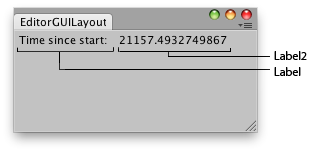

2.Toggle开关按钮
Toggle(bool value,GUILayoutOption[] options)
Toggle(string label,bool value,GUILayoutOption[] options)
//参数:label开关按钮前面的可选标签 value开关按钮的显示状态 options额外布局属性的可选列表
//返回:bool,开关按钮的选择状态
//如果开关控件被选择,显示一个按钮。 bool showBtn =true; voidOnGUI() { showBtn =EditorGUILayout.Toggle("Show Button", showBtn); if(showBtn) { if(GUILayout.Button("Close")) this.Close(); } }
效果:


3.TextField文本字段
TextField(string text,GUILayoutOption[] options)
TextField(string label,string text,GUIStyle style,GUILayoutOption[] options)
TextField(string text,GUIStyle style,GUILayoutOption[] options)
TextField(GUIContent label,string text,GUILayoutOption[] options)
TextField(string label,string text,GUILayoutOption[] options)
TextField(
GUIContent label,
string text,GUIStyle style,GUILayoutOption[] options)
//参数:label可选标签 text编辑的文本 style可选样式 options额外布局属性的可选列表
//返回:string,用户输入的文本
//通过字段,自动改变选择物体的名字 string objectName =""; voidOnGUI() { GUILayout.Label("Select an object in the hierarchy view"); if(Selection.activeGameObject) Selection.activeGameObject.name =EditorGUILayout.TextField("Object Name: ",Selection.activeGameObject.name); this.Repaint();//实时刷新 } }
效果:
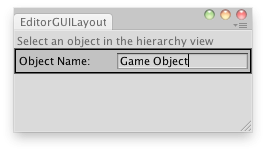

4.TextArea文本区域
TextArea(string text,GUILayoutOption[] options)
TextArea(string text,GUIStyle style,GUILayoutOption[] options)
//参数:text可编辑的文本 style可选样式 options额外布局属性的可选列表
//返回:string,用户输入的文本
//在编辑器窗口可视化脚本,这可扩展保存脚本 string text ="Nothing Opened..."; TextAsset txtAsset; Vector2 scroll; voidOnGUI() { TextAsset newTxtAsset =EditorGUILayout.ObjectField("添加", txtAsset,typeof(TextAsset),true)asTextAsset; if(newTxtAsset != txtAsset) ReadTextAsset(newTxtAsset); scroll =EditorGUILayout.BeginScrollView(scroll); text =EditorGUILayout.TextArea(text,GUILayout.Height(position.height -30)); EditorGUILayout.EndScrollView(); } voidReadTextAsset(TextAsset txt){ text = txt.text; txtAsset = txt; } }
效果:


5.SelectableLabel 可选择标签(通常用于显示只读信息,可以被复制粘贴)
SelectableLabel(string text,GUILayoutOption[] options)
SelectableLabel(string text,GUIStyle style,GUILayoutOption[] options)
//参数:text显示的文本 style可选样式 options额外布局属性的可选列表 无返回值
string text="123"; voidOnGUI() { EditorGUILayout.SelectableLabel(text); //文本:可以选择然后复制粘贴 }
6.PasswordField 密码字段
PasswordField (string
password
, GUILayoutOption[]
options
)
PasswordField (string
password
,
GUIStyle style,
GUILayoutOption[]
options
)
PasswordField (string label
,string password,GUILayoutOption[]
options
)
PasswordField (string
password
,GUIStyle style,GUILayoutOption[]
options
)
PasswordField (GUIContent label,string
password
, GUILayoutOption[]
options
)
PasswordField (GUIContent label,string password
,GUIStyle style,GUILayoutOption[]
options
)
//参数:label开关按钮前面的可选标签 password编辑的密码 style可选样式 options指定额外布局属性的可选列表
//返回:string,用户输入的密码
//创建密码字段并可视化在密码字段有什么键入。 string text ="Some text here"; function OnGUI(){ text =EditorGUILayout.PasswordField("Type Something:",text); EditorGUILayout.LabelField("Written Text:", text); } }
效果:
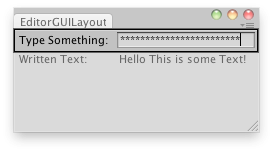

7.制作一个文本字段用于输入小数/整数。
FloatField 浮点数字段:返回小数,由用户输入的值
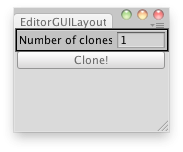
IntField
整数字段:返回整数,由用户输入的值
|
1
2
3
4
5
6
7
8
|
int
clones=1;
voidOnGUI(){
clones=EditorGUILayout.IntField(
"Number of clones:"
, clones);
if
(GUILayout.Button(
"Clone!"
))
for
(
var
i =0; i < clones; i++)
//复制选择物体的次数。
Instantiate(Selection.activeGameObject,Vector3.zero,Quaternion.identity);
}
}
|

8.Slider 滑动条
--IntSlider 整数滑动条
MinMaxSlider 最小最大滑动条
Slider(float leftValue,float rightValue,GUILayoutOption[] options)
Slider(string label,float leftValue,float rightValue,GUILayoutOption[] options)
Slider(GUIContent label,float value,float leftValue,float rightValue,GUILayoutOption[] options)
//参数:label开关按钮前的可选标签 value编辑的值 leftValue滑动条最左边的值 rightValue滑动条最右边的值 options。。。
//返回:float,由用户设置的值
|
1
2
3
4
5
6
7
8
9
10
11
|
//缩放选择的游戏物体,在1-100之间
float
scale =0.0f;
voidOnGUI()
{
scale =EditorGUILayout.Slider(scale,1,100);
}
voidOnInspectorUpdate()
{
if
(Selection.activeTransform)
Selection.activeTransform.localScale =newVector3(scale, scale, scale);
}
|
//随机放置选择的物体在最小最大滑动条之间 float minVal =-10.0f; float minLimit =-20.0f; float maxVal =10.0f; float maxLimit =20.0f; voidOnGUI() { EditorGUILayout.LabelField("Min Val:", minVal.ToString()); EditorGUILayout.LabelField("Max Val:", maxVal.ToString()); EditorGUILayout.MinMaxSlider(ref minVal,ref maxVal, minLimit, maxLimit); if(GUILayout.Button("Move!")) PlaceRandomly(); } voidPlaceRandomly() { if(Selection.activeTransform) Selection.activeTransform.position = newVector3(Random.Range(minVal, maxVal), Random.Range(minVal, maxVal), Random.Range(minVal, maxVal)); else Debug.LogError("Select a GameObject to randomize its position."); }
效果:
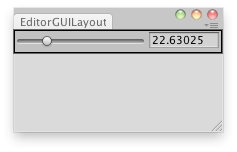
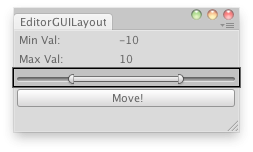


9.Popup弹出选择菜单
Popup(int selectedIndex,string[] displayOptions,GUILayoutOption[] paroptions)
Popup(int selectedIndex,string[] displayOptions,GUIStyle style,GUILayoutOption[] paroptions)
Popup(string label,int selectedIndex,string[] displayOptions,GUILayoutOption[] paroptions)
Popup(GUIContent label,int selectedIndex,string[] displayOptions,GUILayoutOption[] paroptions)。。。。
//参数:label字段前面可选标签 selectedIndex字段选项的索引 displayedOptions弹出菜单选项的数组 style可选样式 options。。
//返回:int,用户选择的选项索引
string[] options ={"Cube","Sphere","Plane"}; int index =0; voidOnGUI() { index =EditorGUILayout.Popup(index, options); if(GUILayout.Button("Create")) InstantiatePrimitive(); } voidInstantiatePrimitive(){ switch(index){ case0: GameObject cube=GameObject.CreatePrimitive(PrimitiveType.Cube); cube.transform.position =Vector3.zero; break; case1: GameObject sphere=GameObject.CreatePrimitive(PrimitiveType.Sphere); sphere.transform.position =Vector3.zero; break; case2: GameObject plane=GameObject.CreatePrimitive(PrimitiveType.Plane); plane.transform.position =Vector3.zero; break; default: Debug.LogError("Unrecognized Option"); break; } } }
效果:


10.EnumPopup 枚举弹出选择菜单(效果同上)
//返回System.Enum,用户选择的枚举选项。
enum OPTIONS { CUBE =0, SPHERE =1, PLANE =2 } publicclass myEditor3 :EditorWindow{ OPTIONS op=OPTIONS.CUBE; [MenuItem("cayman/tempShow")] staticvoid newWelcome() { myEditor3 window3 =(myEditor3)EditorWindow.GetWindow(typeof(myEditor3),true,"Eam"); window3.Show(); } voidOnGUI() { op =(OPTIONS)EditorGUILayout.EnumPopup("Primitive to create:", op); } }
11.IntPopup 整数弹出选择菜单
IntPopup(string label,int selectedValue,string[] displayOptions,int[] optionValues,GUIStyle style,GUILayoutOption[] paramsOptions).....
//参数:label字段前面的可选标签 selectedValue字段选项的索引 displayOptions弹出菜单項数组 optionValues每个选项带有值的数组。。
//返回:int,用户选择的选项的值
int selectedSize =1; string[] names ={"Normal","Double","Quadruple"}; int[] sizes ={1,2,4}; voidOnGUI() { selectedSize =EditorGUILayout.IntPopup("Resize Scale: ", selectedSize, names, sizes); if(GUILayout.Button("Scale")) ReScale(); } voidReScale() { if(Selection.activeTransform) Selection.activeTransform.localScale =newVector3(selectedSize, selectedSize, selectedSize); elseDebug.LogError("No Object selected, please select an object to scale."); }
效果:


12.TagField 标签字段 LayerField层字段
1/ TagField(string label,string tag,GUIStyle style,GUILayoutOption[] paramsOptions)...
//参数:label字段前面的可选标签 tag显示字段的标签 。。
//返回:string,用户选择的标签
2/ LayerField(string label,int layer,GUIStyle style,GUILayoutOption[] paramsOptions)...
参数:label字段前面的可选标签 layer显示在该字段的层。。
//返回:int,用户选择的层
string tagStr =""; int selectedLayer=0; voidOnGUI() { //为游戏物体设置 tagStr =EditorGUILayout.TagField("Tag for Objects:", tagStr); if(GUILayout.Button("Set Tag!")) SetTags(); if(GUILayout.Button("Set Layer!")) SetLayer(); } voidSetTags(){ foreach(GameObject go inSelection.gameObjects) go.tag = tagStr; } voidSetLayer(){ foreach(GameObject go inSelection.gameObjects) go.laye= tagStr; }
效果:

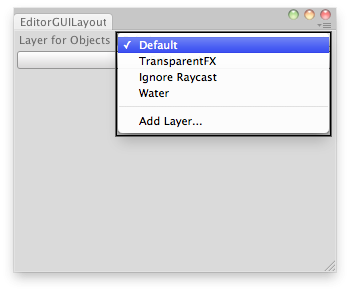


13.ObjectField 物体字段(拖拽物体或拾取器选择物体)
ObjectField(string label,Object obj,Type objType,bool allowSceneObjects,GUILayoutOption[] paramsOptions)
//label字段前面的可选标签 obj字段显示的物体 objType物体的类型 allowSceneObjects允许指定场景物体..
//返回:Object,用户设置的物体
Object source; Texture myme; voidOnGUI() { EditorGUILayout.BeginHorizontal(); source =EditorGUILayout.ObjectField("hiahia",source,typeof(Object)); myme= (Texture)EditorGUILayout.ObjectField("hehe",myme,typeof(Texture));//注意类型转换 EditorGUILayout.EndHorizontal(); }
效果:
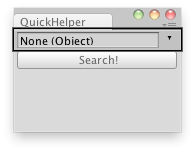

14.Vector2Field 二维向量字段
Vector3Field 三维向量字段(略,同2维)
Vector2Field (string label,Vector2 value,GUILayoutOption[] options)
//参数:label字段前面的可选标签 value编辑的值 options...
//返回:Vector2,由用户输入的值
float distance =0; Vector2 p1, p2; voidOnGUI() { p1 =EditorGUILayout.Vector2Field("Point 1:", p1); p2 =EditorGUILayout.Vector2Field("Point 2:", p2); EditorGUILayout.LabelField("Distance:", distance.ToString()); } voidOnInspectorUpdate()//面板刷新 { distance =Vector2.Distance(p1, p2); this.Repaint(); }
效果:


15.ColorField 颜色字段
ColorField (string label,Color value,...)
//参数:label字段前面的可选标签 value编辑的值
//返回:Color,由用户输入的值
Color matColor =Color.white; voidOnGUI() { matColor =EditorGUILayout.ColorField("New Color", matColor); if(GUILayout.Button("Change!")) ChangeColors(); } voidChangeColors(){ if(Selection.activeGameObject) foreach(var t inSelection.gameObjects) if(t.GetComponent<Renderer>()) t.GetComponent<Renderer>().sharedMaterial.color = matColor; }
效果:
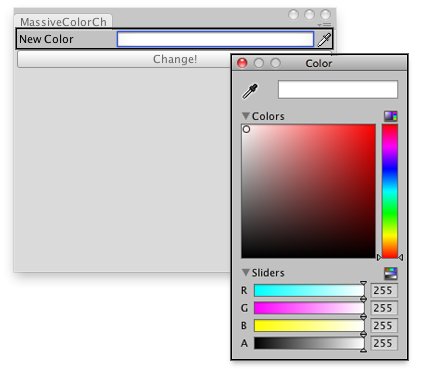

16.
EditorWindow.GetWindowWithRect() 和 EditorWindow.GetWindow()都可以创建一个窗口。前者可以规定窗口的区域,后者可通过鼠标动态的延伸窗口。参数1表示窗口的对象,参数2表示窗口的区域,参数3表示窗口类型true表示窗口不会被别的窗口覆盖,参数4表示窗口的名称。

using UnityEngine;using UnityEditor;publicclassMyEditor:EditorWindow{[MenuItem("GameObject/caymanwindow")]staticvoidAddWindow(){//创建窗口Rect wr =newRect(0,0,500,500);MyEditor window =(MyEditor)EditorWindow.GetWindowWithRect(typeof(MyEditor),wr,true,"widown name");window.Show();}//输入文字的内容privatestring text;//选择贴图的对象privateTexture texture;float myFloat =1.23f;private bool kaiguan;//开关private bool groupEnabled;//区域开关publicvoidAwake(){//在资源中读取一张贴图texture =Resources.Load("1")asTexture;}//绘制窗口时调用voidOnGUI(){//输入框控件text =EditorGUILayout.TextField("输入文字:",text);//3.制作一个文本字段if(GUILayout.Button("打开通知",GUILayout.Width(200))){//打开一个通知栏this.ShowNotification(newGUIContent("This is a Notification"));}if(GUILayout.Button("关闭通知",GUILayout.Width(200))){//关闭通知栏this.RemoveNotification();}//文本框显示鼠标在窗口的位置EditorGUILayout.LabelField("鼠标在窗口的位置",Event.current.mousePosition.ToString());//1.制作一个标签字段(通常用于显示只读信息)showBtn = EditorGUILayout.Toggle("开关", showBtn);groupEnabled = EditorGUILayout.BeginToggleGroup("Optional Settings", groupEnabled);text21 = EditorGUILayout.TextField("请输入帐号:", text21);text3 = EditorGUILayout.PasswordField("请输入密码",text3); //密码输入if (GUILayout.Button("登录", GUILayout.Width(400))){//}int01 = EditorGUILayout.IntField("输入实例化份数:",int01);if (GUILayout.Button("实例化")) //根据份数,实例化选择的物体{for (int i = 0; i < int01; i++){Instantiate(Selection.activeGameObject,Vector3.zero,Quaternion.identity);}}EditorGUILayout.EndToggleGroup();scale1 = EditorGUILayout.Slider(scale1,1,100); //滑动条index = EditorGUILayout.Popup(index,options); //弹出选择菜单if(GUILayout.Button("创建一个")){switch (index){case 0:GameObject cube = GameObject.CreatePrimitive(PrimitiveType.Cube);cube.transform.position = Vector3.zero;break;case 1:GameObject sphere = GameObject.CreatePrimitive(PrimitiveType.Sphere);sphere.transform.position = Vector3.zero;break;case 2:GameObject plane = GameObject.CreatePrimitive(PrimitiveType.Plane);plane.transform.position = Vector3.zero;break;default:break;}}showPosition = EditorGUILayout.Foldout(showPosition, status); //制作一个左侧带有箭头的折叠标签if (showPosition){if (Selection.activeTransform){Selection.activeTransform.position =EditorGUILayout.Vector3Field("Position", Selection.activeTransform.position);status = Selection.activeTransform.name;}if (!Selection.activeTransform){status = "Select a GameObject";showPosition = false;}}//选择贴图texture =EditorGUILayout.ObjectField("添加贴图",texture,typeof(Texture),true)asTexture;groupEnabled =EditorGUILayout.BeginToggleGroup("Optional Settings",groupEnabled);//起始----------------------------//这里放开关区域内内容myFloat =EditorGUILayout.Slider("Slider", myFloat,-3,3);//滑动条kaiguan=EditorGUILayout.Toggle("开关", kaiguan);//2.开关EditorGUILayout.EndToggleGroup();//结束-------------------------------------if(GUILayout.Button("关闭窗口",GUILayout.Width(200))){//关闭窗口this.Close();}}voidOnFocus(){Debug.Log("当窗口获得焦点时调用一次");}voidOnLostFocus(){Debug.Log("当窗口丢失焦点时调用一次");}voidOnHierarchyChange(){Debug.Log("当Hierarchy视图中的任何对象发生改变时调用一次");}voidOnProjectChange(){Debug.Log("当Project视图中的资源发生改变时调用一次");}voidOnInspectorUpdate()//实时刷新面板{//Debug.Log("窗口面板的更新");//这里开启窗口的重绘,不然窗口信息不会刷新this.Repaint();}voidOnSelectionChange(){//当窗口出去开启状态,并且在Hierarchy视图中选择某游戏对象时调用foreach(Transform t inSelection.transforms){//有可能是多选,这里开启一个循环打印选中游戏对象的名称Debug.Log("OnSelectionChange"+ t.name);}}voidOnDestroy(){Debug.Log("当窗口关闭时调用");}}//http://www.ceeger.com/Script/EditorGUILayout/EditorGUILayout.html
然后我们在扩充一下自定义窗口,仔细看看窗口的生命周期。
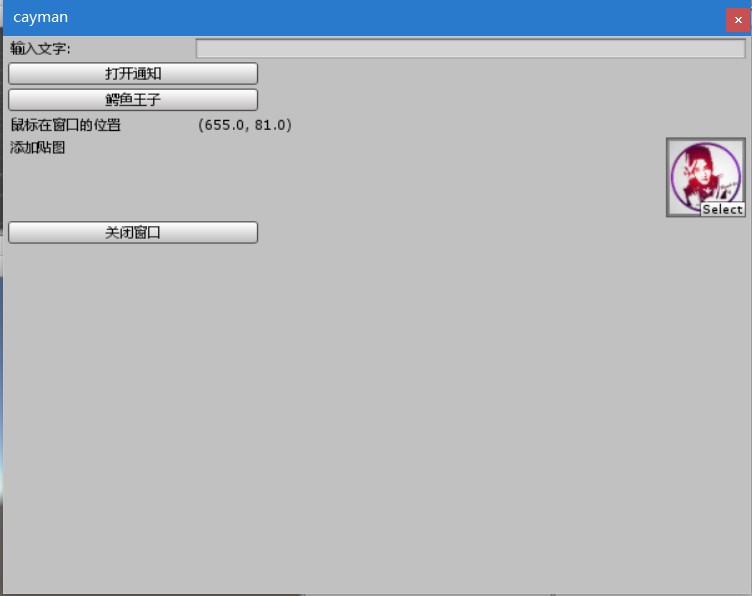






















 3622
3622











 被折叠的 条评论
为什么被折叠?
被折叠的 条评论
为什么被折叠?








